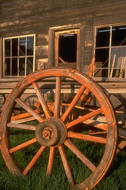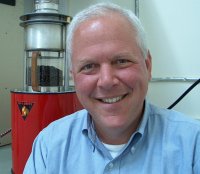About Us
 |
Since their earliest
beginnings, American farms have been the birthplace of
thousands of inventions -–from harvesting machines to the
electric fence. The legendary “Yankee mechanic” was a
rural jack(or jenny)-of-all-trades, whose tinkering brought
about many of the changes that made farm life more pleasant
and productive. Syd and Jerry’s Coffee Roaster is part of
that tradition.
It was developed in
the shop of a small farm on Samish Island,
Washington – a narrow peninsula that juts into the
cold waters of Puget Sound. Neighbors passing by on
their Sunday stroll got used to smelling roasting
coffee as they walked past the chickens, sheep and
fruit trees. |
The idea got started with a snowstorm. In the winter of 1996
a freak storm dumped three feet of snow on Samish Island in
a single day. Besides crushing some older barns, the
snowfall made it impossible to get in to town, and as luck
would have it, the Stapletons ran out of coffee. You may
know how seriously Northwesterners take their coffee. This
was a real crisis.
Just a few months before, the Stapletons had returned from a
year long sailing trip into the Caribbean, and Syd Stapleton
remembered the pound of green coffee beans they had bought
out of curiosity in a little country store on the coast of
Mexico. He found the green beans, and roasted them in a
frying pan on their kitchen stove. It made a smoky mess, but
when he and Anne tried the coffee, they were astonished to
discover that it tasted much better than the $10 or $12 a
pound “gourmet” whole bean coffee that they normally
bought.
This experience, once the snow had melted, led to some
further study. It turned out, Syd read, that farmers had
always roasted their own coffee – up through the beginning
of the Twentieth Century. Until that time, the state of
transportation and packaging made it impossible for people
to get their roasted coffee from central roasting factories.
Then, about the same time that beer, bread and cheese were
turned into industrial products, massive advertising
campaigns convinced Americans that it was more “modern”
to drink stale coffee from cans than to roast it at home.
|

Jerry Whitfield
|
This is where Jerry Whitfield comes in. The Whitfields are
neighbors of the Stapletons, and after the Stapletons got
back from their year long boat trip, the Whitfields became
partners in the 65-year-old wooden schooner that had made
the trip.
Jerry Whitfield had
invented the pellet stove – a revolutionary home
heating device that cleanly burns compressed sawdust
– some years before. He had successfully built up
a company to manufacture the stoves, and holds a
doctorate in combustion engineering. Syd’s
background included many years as a contract
mechanical designer for tool and die shops (and
previous experience as a tool and die maker
himself). |
In retrospect, it seems
almost inevitable that once Syd and Jerry got talking about
roasting coffee, some experimentation would begin. Why, they
asked, shouldn’t everyone have access to freshly roasted
coffee? They found a source for more green coffee, and began
to learn about roasting, starting out with a “heat gun”
that had last been used to strip old varnish off the boat.
|
The next steps led to buying a used milling machine and
borrowing a lathe that had been in a boat building shop in
nearby Anacortes. Over the next two years, they could be
found in the shop, nights and weekends, and any other time
that could be found. The prototypes steadily became more
refined, and Syd and Jerry began some serious investigation
of the current state of the coffee industry.
Talking to restaurant operators about roasting their own
coffee, the most common objection Syd and Jerry heard, in
spite of the potential advantages in quality and cost, was
that life is just too complex to take on learning and
teaching yet another skill. The owner of a popular and
highly regarded Italian restaurant in Seattle said, “I can
barely teach people to make a good espresso! Now you want me
to have them roast the coffee too?!?” |

Syd Stapleton
|
So it became clear that in addition to doing a good job of
roasting coffee, the machine would have to be fully
automatic, using the latest in electronic controls to manage
the roasting process. The goal was to make roasting coffee
as simple as toasting bread.
It took time. A path outside Syd’s house is paved with
rejected coffee beans. But, by refusing to settle for merely
adequate, Syd and Jerry have succeeded in producing a
roaster that produces excellent roasted coffee, time after
time, without the need for a skilled professional roaster.
People did it years ago. Now it can be done again, but more
easily and efficiently, thanks to some work on the farm. |